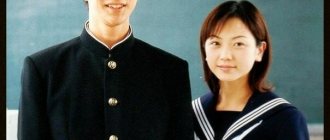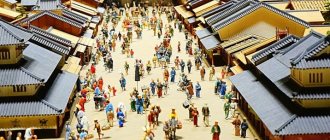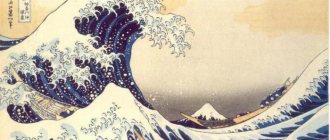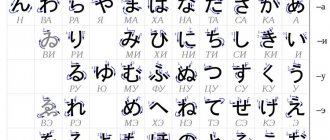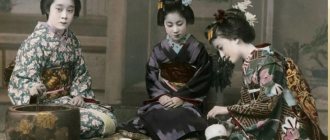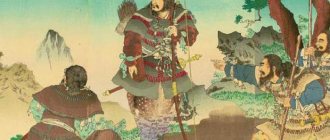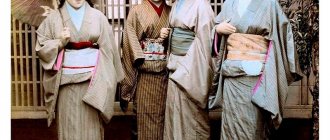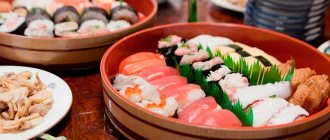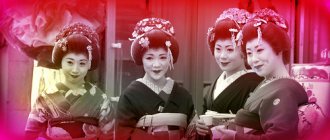Japan is a country of secrets, especially for us Europeans. The Japanese sword is a mystery, the geisha is doubly a mystery, the “Japanese economic miracle” is studied in universities, but no one has been able to repeat it. And yet: what does this “miracle” consist of? What secrets do the Japanese keep about their trading and advertising methods? Today our story will be about how residents of the Land of the Rising Sun use the sound, color and even the rapid movement of high-speed trains to increase the number of sales and, accordingly, purchases, and therefore to strengthen their economy as a whole.
All the bad stuff happens in Japan?
In 1950, after World War II, the nuclear bombings of Hiroshima and Nagasaki and the American occupation, Japan was a very backward power in terms of production (and life too!). In American film comedies of that time, “things that don’t work” were constantly ridiculed: a gun won’t shoot, a car won’t start - and then the hero would usually say: “Well, this was made in Japan!”, and fun in the hall was guaranteed. However, by 1975, everything had changed dramatically, and in 1985, Marty McFly, the hero of the American film “Back to the Future,” on the contrary, told Dr. Brown: “All the best is made in Japan!” And what was the basis for such a wonderful transformation? There are, of course, many reasons. And one of them is the appeal of the Japanese people to their traditions.
Washed away by the wave
The Japanese advertising market is currently at a standstill. The March 11 disaster, which led to the Fukushima Daiichi accident and the nuclear crisis, affected both advertisers and the media. Most of the airtime is still devoted to reporting on the consequences of the disaster. Japanese television broadcasts social advertising of non-profit organizations much more often than commercial videos. Most often on the screens you can see a video from Tepco, the operator of Fukushima-1, in which the company apologizes for the disaster at the nuclear power plant.
Gradually, television and other media began to enter normal broadcast mode. However, it turned out that most advertisers are not ready to place advertising materials during mourning. The Japanese advertising market will shrink by 4.1 percent this year, but will grow by 4.6 percent next year, predicts the ZenithOptimedia agency.
The disaster in Japan has already provoked the emergence of new social advertising in other countries. Thus, in Russia, the advertising agency Dentsu-Smart launched a charity campaign “Respond!” Funds are collected on the website savejapan.ru. Most of the country's largest advertisers and media supported the launched project.
What could be better than tradition?
Japanese culture rests on three pillars: the art of calligraphy, the art of ikebana and the mystery of the tea ceremony. And the spirituality and morality of the Japanese are based on Shintoism (Shinto, or “Way of the Gods”), the traditional Japanese religion. However, this is not a religion in the usual sense, it is a kind of existential philosophy that determines the entire way of life of the Japanese, a set of rules for his behavior and thinking. The main commandment of Shinto is: “Act according to the laws of nature, while sparing the laws of society.” Hence the principle of the importance of what surrounds a person. The Japanese are able to see beauty even in small things, realizing that nothing in the world is insignificant, everything in nature is significant. And it is quite natural that it is easier for a person who understands beauty to create it. Moreover, surprisingly, following traditions makes it easier for the Japanese to create something completely new, since they know what to start from.
“Goku-goku” and crunch-m!
Onomatopoeic words play a large role in the perception of the world around the inhabitants of the Land of the Rising Sun. The ones that reproduce the sounds of wildlife, actions taken, the voices of animals... Skilled designers and advertisers took advantage of the peculiarities of the Japanese language to create informative and aesthetic advertising (which, as you know, is the engine of trade!), and even came up with a name for it - “ shizuru,” a special element that awakens in the buyer the desire to acquire this or that item at any cost. Shizuru is a visual and auditory image of what can be expressed in the following words: “I want to eat this!” and “I want to drink this!” A verbal example of shizuru is the sound made when frying meat - “juu-juu” (remember that there is no “sh” sound in the Japanese language). So the viewer not only watches the picture of the steak being cooked, but also hears its sizzling, and this makes the advertisement doubly attractive. If there is water or beer in a glass, and a Japanese person drinks it, then the advertisement will certainly be accompanied by the sounds of “goku-goku.” If droplets of moisture flow down a tall glass of beer, then it all sounds like this: “fuwa-fuwa.” Eating traditional Japanese rice noodles, ra-men, we hear as “zuru-zuru,” and if something is cooked over a live fire, then “gutsu-gutsu.” Biting off something juicy is accompanied by the sound “crum-m”, but if it’s pizza, then the image is no longer auditory, but only visual - melted strings of cheese stretch from the Italian traditional dish to the lips of the eater - and this awakens the audience’s appetite!
Do you know that…
For 13 centuries, Japan has been fishing with cormorants. The bird is kept on a leash, and to prevent it from swallowing its prey, its neck is bandaged. Cormorants catch only one type of fish - ayu. This method of fishing is called “ukay”.
Advertising of exactly that
Soda advertising from the Suntory company offers a recipe for simple alcoholic cocktails: soda-shka, lemon-pushyun, push-push-push, she!
An advertisement for tea for people suffering from high blood pressure from the same Suntory campaign demonstrates an absurd situation in which this ailment can be useful:
In 2006, a commercial for Kincho cockroach spray was released on Japanese TV channels.
This is a one-minute musical spot starring a Korean pop star who is very popular in Japan. The singer, who, according to music sites, gave the old Korean pansori singing a new sound, is called Epaksa, translated into Russian something like Doctor E. Epaksa sings about how Kincho spray saves from an invasion of cockroaches, demonstrating its effect on plastic representatives of this type. And as incredible as it may sound to us, Epaksa has really been a star in many Asian countries for 20 years, especially in Japan:
Lotte Fit's series of incendiary spots is a test of attentiveness. Did you notice where the girl in the orange dress and dog skin came from?
In addition, Japanese advertisers love to invite Western celebrities to appear in their advertisements. In particular, on YouTube there is a 10-minute selection of videos with the current governor of California, and in the past the savior of the Earth and our future.
And a few more examples:
Advertisement for cookies with milk filling from Kabaya
Advertising for Pretz snacks from Ezaki Glico
Advertising Halls
Color is everything!
The Japanese believe that one of the most important reasons for failures in product promotion is the wrong color scheme. Therefore, color occupies an extremely important place in the Japanese art of communication. And here tradition again comes to the aid of specialists. The fact is that Buddhist wisdom (and Buddhism is the second Japanese religion, and it coexists very peacefully with Shintoism) says: “Everything in this world is illusory. And the only thing that really matters is illusion.” Moreover, the hieroglyph for “color” (“iro”) comes from the hieroglyph for “communication,” and “passion” in Japanese is “irokoi.” Thus, for the Japanese, the use of color is a way of expressing themselves. Japanese buyers believe that the essence of a product is love, and knowing this essence is like falling in love. An example of this is the world-famous Coca-Cola brand. For anyone who sees this red emblem, nothing else will come to mind except the drink that is loved by most of humanity, so much has Coca-Cola captured his consciousness. And there is exactly the same example in Japan. Asahi beer did not sell very well. Advertisers changed the corporate label color, and the company's sales increased sharply. It is well known that approximately 27% of people find one of the shades of dark green to cause nausea, which means that it will certainly never appear on Japanese packaging. In the same way, there are no pink floors in Japan, because some people think that they sag under them...
Advertising is averagely crazy
Dentsu Tokyo agency and Thai director Saton Petchuwan shot a hilarious video about balance in the body for the Dakara drink. The “Balance” video advertises Suntory’s Dakara drink and talks about the wonders of mastering the vestibular apparatus.
New spots from Japanese food manufacturer Lotte advertise two chewing gum brands, Lotte Acuo and Lotte Fit's. The first, a kind of Ax-effect in Japanese, demonstrates how chewing gum not only freshens breath, but also turns the girls around the guy into anime characters.
The Japanese online hotel and ticket booking service Jalan.net uses a cat in its advertising. Nyalan the cat (“nya” is Japanese for “meow”) has long been the face of Jalan.net and the main character in all its commercials. In a series of spots, of which a decent number have already been released, the cat’s adventures in hotels and travel are shown. He lives on an equal footing with ordinary people and experiences all the delights of hotel service.
Japanese agency Build Creativehaus shot an advertisement about the benefits of Kohara GearIndustry Co. gears. One of the main disadvantages and an indicator of poor quality gears is their squeaking during operation. It was the creaking and grinding of metal gears that formed the basis of the “Creaky/Creaks” advertising campaign. According to Japanese creatives, this sound is very similar to the voices of people swearing.
The video for the promotion of the Esthe WAM Beauty Spa hair removal studio shows an incredible story with a girl whose smooth armpits reflected the sun with a laser beam. Hair removal in Asia is advertised using a situation unthinkable for the European mentality - the sun from the armpits is reflected by a laser beam and “fries” those around. The atmosphere of the video, the acting of the supporting actors and the details of the setting are no less comical.
And one more video for Esthe Wam to cement the impressions.
"Natural beauty"
The main thing about color, according to the Japanese, is its “natural beauty”. Since everything in the Universe is dualistic, that is, dual, and is subordinate to the “yin-yang” vector, then if we find these signs in everything that surrounds us, the harmony of nature will be revealed to us. Having known it, we will help other people to know harmony. So, if “yin” is the Moon, then “yang” is the Sun, and, accordingly, each element of nature has its own color. The color corresponds to a tree is blue (green) - “trees turning blue in the morning haze”; Fire - red, Earth - yellow (brown), Metal - white, and Water - black. All these colors are an expression of all nature, and their shades also matter. This interpretation of colors was used for the new cosmetics brand “Sinoadoa”, which has become extremely popular since 2002. When company employees are asked what colors mean in their understanding, they readily explain: white color is purification, eternity, peace; black - a mixture of all colors - chaos, omnipotence, admiration; blue (green) - intelligence, wisdom; red - happiness, life, fate; yellow - earth, center, worship. In addition, yin and yang appear in shades of gold and silver. At the same time, Siseido specialists also take into account such “little things” as the popularity of color in a particular country. In China, for example, marble blue or marble white is considered a favorite color that can attract attention. There was a kind of taboo on the use of black in the design of cosmetics packaging. However, now the attitude towards it has changed, and the black and gold boxes have received the approval of Chinese buyers.
Crowdfunding in action.
Crowdfunding is an unusual word for the common man, but it is also a novelty for entrepreneurs. But the devil is not as scary as he is painted! In English, “crowdfunding”[1], and in Russian, “collective” or, more precisely, “popular” financing, originates in the USA at the end of the 20th century, when the rock band Marillon secured a tour with funds fans. The reaction of Internet entrepreneurs was not long in coming: three years later, sites began to appear that collected money from fans and lovers of music/video/games/etc. money to launch your projects.
[1] From English. “crowd” - crowd, collective, “funding” - sponsor.
Number of impressions: 1038
Forex – is it really possible to make money?
The question of making money on the Forex market interests many people and opinions on this matter are very contradictory. A way to make money or a scam? Let's try to figure this out... On the one hand, probably everyone has heard or read stories of huge profits earned on the Forex market. On the other hand, there are many people who have lost their money and say that it is impossible to make money there. But in reality, those who really make money in this market remain in the shadows because they work, spending enough effort and time.
Number of impressions: 3573
Russia and the WTO: first results, prospects.
For the past 20 years, Russia has worked diligently to become a member of the World Trade Organization (WTO), and throughout this time, debate has raged about the advantages and disadvantages of membership. For more than a year now, the Russian Federation has been a member of the WTO along with other 159 countries of the world.
Number of impressions: 23276
The problem of bankrupt US cities and national debt. The US solves problems at the expense of other countries.
The US national debt currently stands at 73% of GDP, the highest in the country's history except for a brief period during World War II.
Everyone has long been aware of the situation in the United States. The size of the national debt of this country is about 16 trillion dollars, however, there is an opinion in the media about GDP growth in both the United States and the European Union. A number of scientists have conducted their research and are convinced that everything is not so rosy.
Number of impressions: 2730
Options trading is profitable! Truth or lie?
Continuing the conversation about operations related to trading securities, I would like to pay attention to options
, tools that are also not known to everyone and raise a number of questions.
Currently option
- the most effective trading tool that will help you make a profit.
Options are quite inexpensive and, if used correctly and wisely, significantly reduce financial risks. Number of impressions: 1233
Scalping. Without harm to people, with benefit for you.
Trading the stock markets has and will always remain the hard way to an easy life.
Probably every person who is in some way connected with the economy has sometimes thought that trading securities is quite a profitable activity if you know how to competently apply your knowledge, skills and intelligence. However, few people know that there are many types and combinations of securities trading. If you look through various exchange and auction sites, you can stumble upon one very interesting and little-known type of operation, the name of which at first may cause a double impression of the essence of such an activity. We are talking about scalping.
Number of impressions: 1159
Social advertising in the East and West: Japan vs USA
From its inception to the present day, advertising has repeatedly changed both form and content. If she began her creative career as a “barker”, attracting attention to a product or service, then in the 20th century it became clear that she was capable of more: to be not only an “engine of trade,” but also to create “the image of morality.” Thus, a new direction of advertising activity was formed - social advertising.
Number of impressions: 6812 News 1 - 7 of 7 Home |
Prev. | 1 | Track. | End | All
Advertising at speed!
Using every centimeter of space as efficiently as possible, the Japanese have made outdoor advertising a part of the urban landscape and a lifestyle. It decorates and transforms the monotony of gray streets, creates comfort in the rapid rhythm of Japanese everyday life and... in the rapid rhythm of Japanese transport, especially underground. Like us, in Tokyo and other Japanese cities there are a lot of advertisements at subway stations and in passages. However, if while a train is moving in the Russian metro, only solid blackness is visible through the window, or behind it stretch the walls of a tunnel with “decorations” in the form of cables, then with the Japanese everything is different. A unique feature of the Japanese subway is “tunnel advertising”: huge posters, which are storyboarded video sequences, are viewed at high speed from the car window like a video.
Magazine: Secrets of the 20th Century No. 8, March 2011 Category: Unknown about the known Author: Vyacheslav Shpakovsky
Tags: trade, Secrets of the 20th century, Japan, sound, purchase, advertising, color, movement, philosophy, product
- Back
- Forward
Second place in numbers
In recent years, Japan has consistently ranked second in the world in advertising spending. The turnover of the advertising market in 2010, according to estimates by the largest Japanese advertising agency Dentsu, amounted to about 5.8 trillion yen (68.8 billion US dollars). ZenithOptimedia offers slightly different data - a Western media company estimated the size of the Japanese advertising market at $43.2 billion. For comparison, similar expenses in Russia amounted to $8.8 billion in 2010.
The Japanese, following the global trend, prefer to advertise on television. It took about a third of the annual turnover - 29.6 percent (1.7 trillion yen). In second place in terms of spending is advertising on the Internet - 13.3 percent (774 billion yen). In the near future, this sector will exceed total print media advertising spending (newspapers and magazines together accounted for 15.7 percent, or 913 billion yen).
Japan is one of the world leaders in terms of the pace of development of the online advertising market. The main features of the Japanese advertising market in this sector are the Japanese love for Twitter and the mobile Internet.
In terms of the number of Twitter users, Japan is ahead of all countries in the world. According to preliminary estimates from Digital Garage Inc, which provides access to the service, advertising costs on Twitter will be about 8.5 billion yen ($101 million) by mid-2011.
The second priority area of Internet advertising in Japan is advertising in the field of mobile Internet. It is worth mentioning here the product barcodes that are placed on each product. By photographing such a barcode on your mobile phone, you can find information about the product on the Internet in a few seconds. This has become common practice in Japan, and many advertising posters, advertisements and products themselves are equipped with these barcodes. And manufacturers are trying to spend significant amounts of money on maintaining the image of their product on the Internet.
Japanese advertising spending in 2010 decreased by 1.3 percent compared to 2009. However, in 2009, advertising spending fell by 11.5 percent, so before the March 11 disaster, there was talk of a market recovery.
